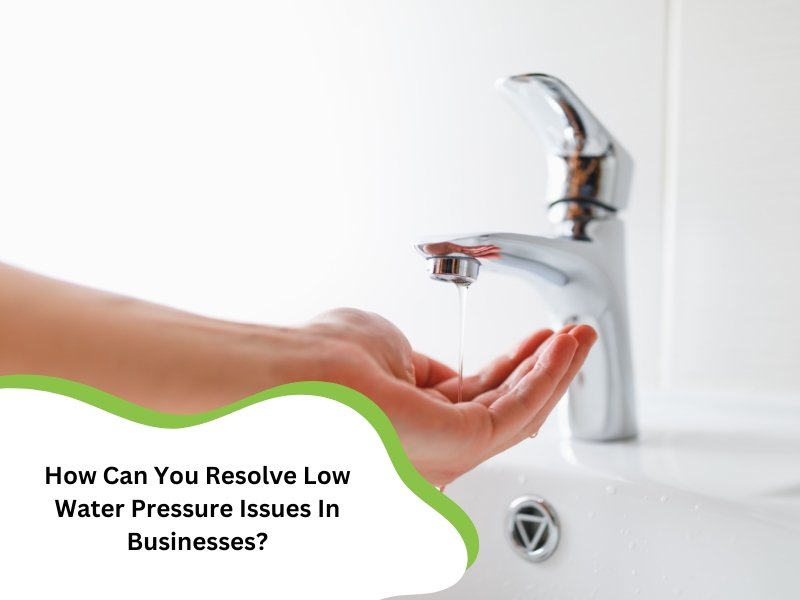Low water pressure is a frequent problem for many businesses in Sydney. Whether you’re running a café, office, or retail store, low water pressure can interfere with daily operations and impact customer satisfaction. If you’re dealing with low water pressure, it’s crucial to tackle the issue promptly to prevent delays. This article will cover the causes of low water pressure, how to identify the problem, and how to fix low water pressure with eco-friendly solutions to restore optimal water flow.
What causes low water pressure in businesses?
Various factors can cause low water pressure in businesses. Understanding these causes is the first step in knowing how to fix low water pressure. Here are the common reasons:
- Pipe blockages: Over time, debris and mineral build-up can block pipes, leading to reduced water flow.
- Water leaks: Hidden pipe leaks can significantly reduce water pressure, particularly if they remain undetected.
- Faulty pressure regulators: A defective pressure regulator can lead to fluctuations or a decrease in water pressure.
- Municipal supply issues: In some cases, the issue may be related to the water supply from the city or region, particularly during peak usage times.
- Old or corroded pipes: Older pipes, particularly those made from steel or iron, can corrode and restrict water flow.
Shared Water Systems: In commercial buildings, shared plumbing systems can reduce pressure if other tenants are using water at the same time.
How can you diagnose low water pressure issues?
Diagnosing the cause of low water pressure requires careful investigation. Here are the steps you can take:
- Check multiple outlets: Test water pressure at various outlets throughout the business. If only one tap or fixture is affected, the problem could be localised to that fixture.
- Inspect for Lleaks: Walk around your business and check for visible leaks or damp spots, which could indicate a leak in the plumbing.
- Examine pressure regulator: If your business has a pressure regulator, check to ensure it is functioning correctly. A faulty regulator could be the culprit.
- Evaluate pipe condition: Look for signs of corrosion, especially in older buildings. Corroded pipes can severely restrict water flow.
- Monitor water consumption: Check if the low pressure occurs during peak usage times. Overusing water during busy hours could be the cause.
What are the eco-friendly ways to fix low water pressure?
As businesses become more environmentally conscious, finding eco-friendly solutions to fix low water pressure is a great option. Here are some effective methods:
- Install a water pressure booster: A water pressure booster can help increase water flow without wasting excess water, which is a more energy-efficient solution than upgrading the entire system.
- Pipe insulation: Insulating pipes can reduce heat loss and improve the efficiency of your plumbing system, helping to maintain water pressure.
Water-Efficient Fixtures: Replacing old fixtures with low-flow taps and showers can help reduce the amount of water used without compromising pressure. - Rainwater harvesting: Installing a rainwater collection system can supplement your business’s water supply, especially for non-potable uses, reducing the demand for municipal water.
- Regular pipe maintenance: Keeping your pipes clean and well-maintained can prevent build-ups that might hinder water flow and pressure.

Can old plumbing systems be the cause of low pressure?
Yes, old plumbing systems are a common cause of low water pressure. In many older buildings, the plumbing system was designed to handle much lower water usage. Over time, the pipes can become corroded, leading to blockages. Here are some reasons why old plumbing can contribute to low water pressure:
- Corroded pipes: Over time, rust and mineral deposits can build up inside the pipes, reducing their diameter and restricting water flow.
- Outdated materials: Older systems often use materials like galvanised steel, which can corrode and weaken, leading to water pressure issues.
- Leaky pipes: Old plumbing is more prone to leaks, which can divert water from its intended path, lowering pressure.
- Faulty valves: In older plumbing systems, valves may become incorrect or worn, leading to inconsistent water pressure.
- Increased water demand: Older systems weren’t designed for modern water usage demands, and as a result, they may struggle to provide adequate water pressure during peak usage.
How does water usage affect water pressure in commercial spaces?
In commercial spaces, water usage often fluctuates depending on the time of day, the number of customers, and the nature of the business. This can have a significant impact on water pressure. Here are some key factors to consider:
- High water demand: During peak business hours, water usage can spike, leading to a temporary drop in pressure, especially in shared water systems.
- Multiple fixtures in use: If several outlets, such as taps, toilets, and showers, are used simultaneously, the combined demand can cause a drop in pressure.
- Water consumption patterns: Due to high demand, businesses with high water needs, such as restaurants or laundromats, may experience consistently low water pressure.
- Building size and layout: Larger commercial buildings or multi-storey businesses may experience water pressure drops on higher floors due to the distance water must travel.
What role do water-saving devices play in maintaining water pressure?
Water-saving devices are crucial in maintaining good water pressure while also reducing water consumption. Here’s how they contribute:
- Low-flow fixtures: These water-saving fixtures employ cutting-edge technology to ensure sufficient water pressure while minimising water consumption, offering an environmentally conscious choice.
- Water-saving aerators: Aerators can be installed on taps and showerheads to mix air with the water, providing a fuller spray while using less water.
Dual-Flush Toilets: These water-saving toilets feature two flush settings, enabling businesses to reduce water consumption while maintaining effective waste removal - Water-efficient hot water systems: Modern, energy-efficient hot water systems conserve energy and help ensure consistent water pressure.

When should you call a professional plumber for help?
While business owners can handle some plumbing issues, there are times when you should call a professional commercial plumbing service. Here are the signs that indicate it’s time to get help:
- Persistent low water pressure: If the problem continues despite troubleshooting, a professional plumber can diagnose the root cause.
- Visible leaks: If you notice visible water damage or suspect hidden leaks, it’s crucial to have a plumber inspect the system.
- Water quality issues: If water pressure is accompanied by discolouration or foul smells, it’s best to have an expert assess your system.
- Old or damaged pipes: If your plumbing system is old or you suspect it’s corroded, a plumber can assess whether repairs or replacements are needed.
- Pressure fluctuations: If water pressure is inconsistent or fluctuates during the day, it’s a good idea to consult a plumber for an inspection.
Need Commercial Plumbing Help? Eco Plumbers 24/7 Has You Covered!
If your business has low water pressure, Eco Plumbers 24/7 is here to help. Our team of experts offers reliable, eco-friendly plumbing solutions to ensure your business runs smoothly. From emergency plumbing repairs to water-saving device installations, we’ve got you covered. Contact us today for a consultation or to schedule a service.
Call Eco Plumbers 24/7 for all your commercial plumbing needs in Sydney!

